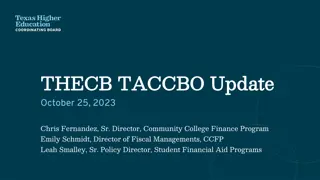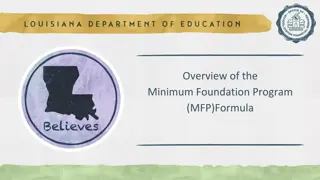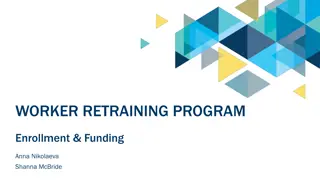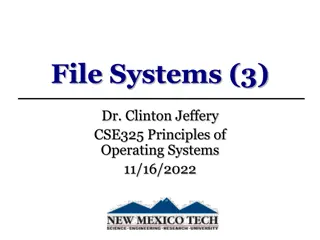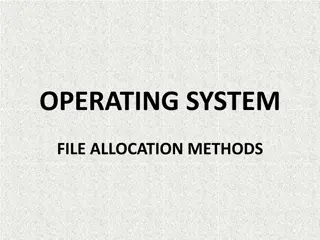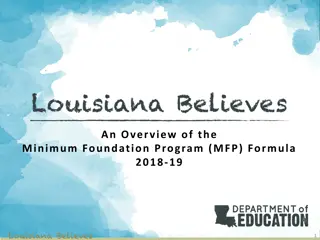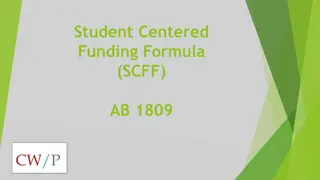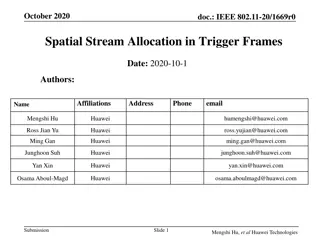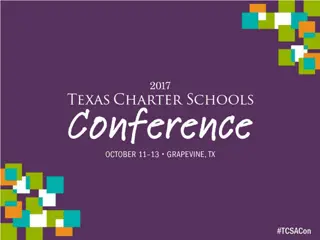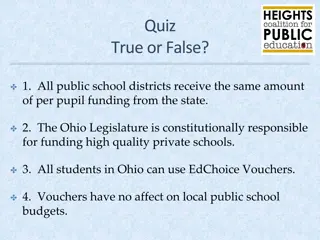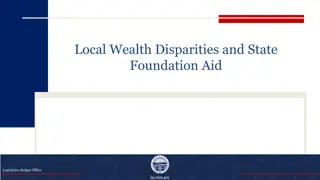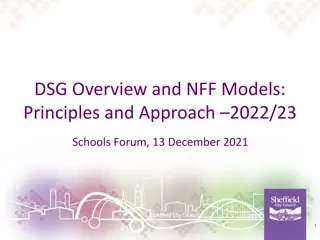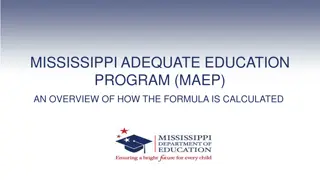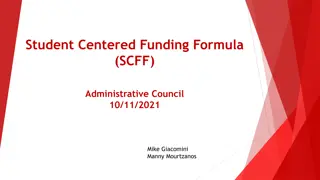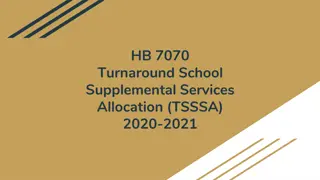School Funding Formula and DSG Allocation Overview
The Dedicated Schools Grant (DSG) funding allocation process, how it is distributed to schools, factors affecting funding, and the timeline of allocation from the Education Funding Agency (EFA) to Local Authorities (LA) and then to schools through formula factors. Emphasis on pupil-led funding and the School Budgets Forum involvement in determining funding factors.
Download Presentation

Please find below an Image/Link to download the presentation.
The content on the website is provided AS IS for your information and personal use only. It may not be sold, licensed, or shared on other websites without obtaining consent from the author.If you encounter any issues during the download, it is possible that the publisher has removed the file from their server.
You are allowed to download the files provided on this website for personal or commercial use, subject to the condition that they are used lawfully. All files are the property of their respective owners.
The content on the website is provided AS IS for your information and personal use only. It may not be sold, licensed, or shared on other websites without obtaining consent from the author.
E N D
Presentation Transcript
School Funding Formula and how the Dedicated Schools Grant (DSG) is allocated Ian Hamilton, School Budgets & PVI Manager
Overview and Introduction The aim of today is to broaden your understanding on how DSG funding is allocated to schools DSG funding is initially allocated by the Education Funding Agency (EFA) to the Local Authority (LA) and then the LA allocates it to schools DSG funding is allocated in two ways -through formula factors or named pupil funding (high needs), the latter we are not covering today DSG funding allocated to schools through formula factors is known as the schools block Both LAs and Schools are funded on the October census count for the financial year April to March For an Academy the count date is the same (October Census) but financial year is September to August
Overview and Introduction - continued EFA notify the LAs of its DSG in December - this is based on the total number of pupils aged 5 to 16 years, recorded on the October census (includes all academies and free schools in the LA) Kent s DSG per pupil is 4,363 This is LA specific and the national funding range is 4,151 to 7,007, the mean average is 4,612 Flat Cash DSG - The DSG has been frozen since 2010-11(5 years to date), the governments intention is to continua flat cash for the duration of the parliament, another 5 years The DSG received from the EFA is then allocated using a local formula, funding targeted at the pupil need within the school There are 14 allowable factors determined by the EFA, therefore LAs have some local discretion, emphasis of funding is pupil led
Overview and Introduction - continued Schools Funding Forum (SFF) and Members determine the factors to be used in the formula LAs submit school budget calculation to EFA around the 20 January this is checked by the EFA and early in February LAs receive confirmation that the calculation complies with finance regulations EFA take back funding for academies and free schools (recoupment) Schools budgets issued on the last working day of February for the period April to March.
Factors used to distribute DSG funding in Kent s local formula Funding is for the period April to March and in general is based on the October census count The number of funded pupils will be the number of pupils on roll at the October census less any pupils in a Specialist Resource Provision (SRP) Important to note it is a formula that targets funding and it is at the schools discretion how this funding is best utilised. The school has a responsibility to achieve the best outcome for its cohort of pupils
Factor 1 (Basic Entitlement) Age Weighted Pupil Unit (AWPU) Mandatory factor 77.3% of DSG is allocated through this factor. What is funding targeted at general running costs of the school, Headteacher, classroom teacher etc. Long history of how this factor has been built up- examples include an element for teachers pay grant and premises. Indicator - Number of pupils on roll taken from the October census Rate Primary Year R to Year 6 - 2,740 Secondary KS3 Year 7 to Year 9 - 3,807 Secondary KS4 Year 10 to Year 11 - 4,173 Year R uplift. Increase in Year R pupils between October and January census. Calculation for funding year 2015-16 Pupils Year R 2014 January census less pupils Year R 2013 October census- always one year behind
Factor 2 Deprivation Mandatory factor LAs may choose to use free school meals (FSM) and/or the Income Deprivation Affecting Children Index (IDACI). Free school meals can be measured either at the previous October census or ever 6 the number of pupils entitled to free meals at any time in the last 6 years but not both. Kent use FSM (October census) and IDACI FSM 1.09% of DSG is allocated through this factor What is funding targeted at if a pupil is eligible for a FSM the school has a statutory requirement to provide a meal for that pupil, this factor is a contribution towards the cost of the FSM Indicator - Number of FSM pupils on roll taken from the October census. Rates Primary 359 per pupil Secondary - 334 per pupil
Factor 2 Deprivation (continued) IDACI 4.09% of DSG is allocated through this factor It is a notional SEN factor What is funding targeted at Primarily social need and Special Education Needs (SEN) Indicator IDACI score based on pupils post code. Each pupil will be placed in one of the six funded bands, band six being the most deprived. The number of pupils in each band will then be shown as a % of the number of pupils on roll at the October census. Rates Band1 Band 2 Band 3 Band 4 Band 5 Band 6 Primary 415 435 468 515 566 708 Secondary 447 469 504 554 610 763
Factor 3 Looked after Children (LAC)- Optional factor 0.08% of DSG is allocated through this factor It is a notional SEN factor What is funding targeted at LAC Indicator No. of LAC children at 31 March recorded on LA SSDA903 return. This data is then mapped to the number of pupils on roll at January census. The % is then multiplied by the number of pupils on roll at the October census Rate Primary and Secondary - 525 per pupil
Factor 4 English as Additional Language (EAL) Optional factor 1.45% of DSG is allocated through this factor It is a notional SEN factor What is funding targeted at Children where English is not their first language. The aim is to target the funding in the early stages of education for the first three years. LA can target for 1,2 or 3 years Indicator No. of children recorded on the October census where English is not their first language Rate Primary 885 per pupil Secondary - 3,344 per pupil
Factor 6 Low cost high incidence SEN Optional factor 4.40 % of DSG is allocated through this factor It is a notional SEN factor What is funding targeted at for children with low level SEN, the rational is that in general pupils with SEN have low Prior Attainment (PA) scores Indicator Primary October census taken from Early Years Foundation Stage Profile (EYFSP) - No. of children in Year groups 1 & 2 identified as not achieving the expected level of development and No. of children in Year groups 3 to 6 who have a point score of below 78 Secondary October census No. of pupils not reaching level 4 at KS2 in either Maths or English Rate Primary 749 per pupil Secondary - 863 per pupil
Factor 7 Lump Sum Optional factor 8.18 % of DSG is allocated through this factor Part of lump sum is notional SEN (Primary 6,235 and Secondary 5,580) What is funding targeted at Primarily included for small primary schools in the recognition that there are some core cost that relate to all schools Indicator One lump per school no matter how many pupils Rate - Primary and Secondary - 120,000 per school
Factor 9 London Fringe Optional factor 0.20 % of DSG is allocated through this factor What is funding targeted at - The purpose of this factor is to support schools which have to pay higher teacher salaries because they are in the London fringe area Indicator Only applies to schools in Dartford and Sevenoaks Rate - 1.56 % times factors 1 to 7
Factor 11 Non-domestic rates (NDR) Optional factor 1.30 % of DSG is allocated through this factor What is funding targeted at Actual cost of NDR Indicator actual cost
Factor 12 Private Finance Initiative (PFI) Optional factor 1.00 % of DSG is allocated through this factor What is funding targeted at Additional cost of PFI contract attributed to school that is above the normal contribution made by a school for premises related activities Indicator actual cost of contract
Notional SEN Factor 2 IDACI Factor 3 LAC Factor 4 EAL Factor 6 Low cost high incidence SEN PA Factor 7 Part of the Lump sum (Primary 6,235 and Secondary 5,580) Definition Funding targeted at low level SEN pupils
Minimum Funding Guarantee (MFG) Why do we have a MFG? To provide schools with a level of stability from year to year. Since 2011-12 the MFG has been set at minus 1.5% or at 98.5 % of the previous years funding Important to note, not based on the total budget from the previous year, but on average pupil funding less exempt items (lump sum and NDR).
MFG - continued A 2014/15 Formula Budget 587,443 Funding Less 2014-15 NDR 8,917 B 2014-15 Lump Sum 121,876 C SEN Baseline Adjustment 10,525 D Total exempt items 141,318 (B+C+D) E MFG Baseline 446,126 (A-E) F October 2013 Pupil Numbers 127 G 3,513 MFG per pupil (F/G) H 53 1.5% of MFG per pupil (H x 1.5%) I 3,460 MFG per pupil less 1.5% (H-I) J October 2014 Pupil Numbers 145 K MFG Excluding Exempt Items 501,716 (K x J) L
MFG - continued Plus 2014-15 NDR 9,121 M 2014-15 Lump Sum 121,876 N Total exempt items 130,997 (M+N) O MFG 632,713 (L+O) P Formula budget 2015-16 610,000 Q Schools will receive greater MFG or Formula 632,713 Greater P or Q R MFG 22,713 (R - Q) S Final Allocation 632,713 R T
Estimating future years funding We use the MFG to estimate future years funding Why do we use the MFG and why not use a different method for calculating the funding ? Reasons why we use MFG For many years we have only been given a one year funding settlement, therefore can not say with certainty what the future holds No increase to DSG so unlikely to see material increase to funding Any changes would likely be subject to the MFG It is a simple methodology to understand and is prudent
Estimating future years funding - continued When estimating future years income we need to understand what the MFG is telling us This is best done at a school level, as business managers have local knowledge and need to understand the application of the MFG When should a school apply the MFG and when should the school not apply the MFG? This is best demonstrated using a set of examples
Example A Example 1 MFG or Formula ? Year 1 A Formula 900,000 B MFG 100,000 C Total Budget 1,000,000 Year 2 - estimate E MFG Budget X 98.5% 985,000 (C X 98.5 %) F Formula Year 2 900,000 G MFG 85,000 H 985,000Greater E or F
Example B Example 2 MFG or formula Year 1 A Formula 1,000,000 B MFG 0 C Total Budget 1,000,000 Year 2 - estimate E MFG Budget X 98.5% 985,000 (C X 98.5 %) F Formula Year 2 1,000,000 G MFG H 1,000,000Greater E or F
Example C Example 3 MFG or formula Year 1 A Formula excluding EAL 950,000 B EAL (final 3rd year) 50,000 C MFG 0 D Total Budget 1,000,000 Year 2 - estimate E MFG Budget X 98.5% 985,000 (C X 98.5 %) F Formula Year 2 (no EAL funding) 950,000 G MFG 35,000 H 985,000Greater E or F


